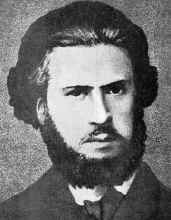The New Yorker Rejects Itself: A Quasi-Scientific Analysis of Slush Piles | The Review Review
Aha! I thought so. The title is not quite accurate — The New Yorker didn't exactly reject itself, but… Well, read what happened.
We destroy the beauty of the countryside because the un-appropriated splendors of nature have no economic value. We are capable of shutting off the sun and the stars because they do not pay a dividend. — John Maynard Keynes
2013/03/21
The Middle East Times - International
My thanks to friend César Chelala for this article on the so-called "Peace Process":
The Middle East Times - International
I think he's right in his analysis, and I've sent him this comment about the overabundant press attention to the issue:
We are now almost overwhelmed with messages about this conflict, a lot of heat and too little light. Things are changing there — Netanyahu's base is eroding, his new alliances forcing him to break with the older ones, and any such shift creates little openings which a smart opposition could exploit. But of course the opposition is too busy fighting among themselves, Hamas against Fatah, each against its own internal Palestinian critics, Israeli peaceniks like Amos Oz unwilling to join forces with Israeli Arab parties, all of which leaves an agile opportunist like Netanyahu free to cobble together whatever kind of coalition can keep him in office. And meanwhile, the settlements keep encroaching on Palestinian land, making a peaceful settlement ever more difficult.
The Middle East Times - International
I think he's right in his analysis, and I've sent him this comment about the overabundant press attention to the issue:
We are now almost overwhelmed with messages about this conflict, a lot of heat and too little light. Things are changing there — Netanyahu's base is eroding, his new alliances forcing him to break with the older ones, and any such shift creates little openings which a smart opposition could exploit. But of course the opposition is too busy fighting among themselves, Hamas against Fatah, each against its own internal Palestinian critics, Israeli peaceniks like Amos Oz unwilling to join forces with Israeli Arab parties, all of which leaves an agile opportunist like Netanyahu free to cobble together whatever kind of coalition can keep him in office. And meanwhile, the settlements keep encroaching on Palestinian land, making a peaceful settlement ever more difficult.
2013/03/18
On Questioning the Jewish State - NYTimes.com
A pretty convincing argument, it seems to me. The whole idea that Jews are a distinct "people", implying some genetic particularity or some other quality that makes them unassimilable to other nations, was an argument of racists, as Levine reminds us.
On Questioning the Jewish State - NYTimes.com
On Questioning the Jewish State - NYTimes.com
Constructing a novel
A good omen! Today, on precisely the 142d anniversary of the beginning of the Paris Commune, this book (ordered from amazon.fr) has arrived:
Very likely you have never heard of Eugène Varlin. I first discovered him about a year ago, first in brief mentions as a member of both the Commune (that is, an elected member of its governing body) and the International Workingmen's Association (later known as the First International). The more I learn about his brief life — he was murdered in the final days of the semaine sanglante, 22-28 May 1871, when he was not yet 32 — the more deeply he impresses me. He is just one of many remarkable and admirable heroes and heroines of that glorious, disastrous social experiment, Paris in the spring — Le temps des cerises, as the song put it — of 18 March to 28 May, 1871.
But for my novel, Varlin — worker, theorist, promoter of women as equals in the struggle, and ultimately as a combattant — will be a key to the dynamics of that great uprising and improvised creation of a new social order.
The greater weight of my story will be borne by my fictional characters, but to construct for the reader they world they move in I need to use the real streets, the bricks, the cannons and figures including Varlin, and Louise Michel, Nathalie Lemel, Jaroslav Dombrowski, and many others who may be mentioned only fleetingly in the novel. But all are part of its real setting.
And today, 18 March, in the anniversary of the almost accidental, chaotic first revolt against an abusive authority — Thiers' failed attempt to remove the National Guard's cannons from Montmartre — that began the revolt that became the model for Lenin's State and Revolution and every modern urban uprising since.
Varlin, Eugène, y Paule Lejeune. Pratique militante & écrits d’un ouvrier communard. Paris: Harmattan, 2002.
 |
| Eugène Varlin, October 5, 1839-May 28, 1871 |
But for my novel, Varlin — worker, theorist, promoter of women as equals in the struggle, and ultimately as a combattant — will be a key to the dynamics of that great uprising and improvised creation of a new social order.
The greater weight of my story will be borne by my fictional characters, but to construct for the reader they world they move in I need to use the real streets, the bricks, the cannons and figures including Varlin, and Louise Michel, Nathalie Lemel, Jaroslav Dombrowski, and many others who may be mentioned only fleetingly in the novel. But all are part of its real setting.
And today, 18 March, in the anniversary of the almost accidental, chaotic first revolt against an abusive authority — Thiers' failed attempt to remove the National Guard's cannons from Montmartre — that began the revolt that became the model for Lenin's State and Revolution and every modern urban uprising since.
2013/03/17
Frustrated Bourbons vs. Urban Reality in Old Mexico
 |
| El Segundo Conde de Revillagigedo |
Frustrated Bourbons vs. Urban Reality in Old Mexico - showpdf.php
Subscribe to:
Posts (Atom)